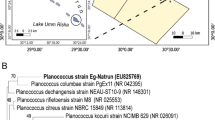Abstract
The main pigment fromPseudomanas paucimobilis (formerly, Weaver's group IIk, biotype 1), a bacterium isolated from the hospital environment or clinical pecimens and sometimes confused with members of the genusXanthomonas, has been shown to be the carotenoid (2R, 3R, 2′R, 3′R)-β,β-carotene-2,3,2′,3′-tetrol (nostoxanthin) rather than a brominated aryl-polyene (xanthomonadin) pigment of the sort characteristically and invariably made by phytopathogenicXanthomonas species. This identification was based primarily on mass spectrometric, nuclear magnetic resonance, and circular dichroism data. Nostoxanthin has hitherto been reported to occur only in a few species of cyanobacteria. Hence, the formation of nostoxanthin byP. paucimobilis might serve as a chemotaxonomic marker for this nonphotosynthetic bacterial species. Certainly, it supports the placement ofP. paucimobilis outside the genusXanthomonas.
Similar content being viewed by others
Literature Cited
Andrewes, A. G., Borch, G., Liaaen-Jensen, S., Snatzke, G. 1974. Animal carotenoids. 9. On the absolute configuration of astaxanthin and actinioerythrin. Acta Chemica ScandinavicaB28:730–736.
Britton, G., Goodwin, T. W. 1971. Biosynthesis of carotenoids. Methods in Enzymology18C:654–701.
Buchecker, R., Liaaen-Jensen, S., Borch, G., Siegelman, H. W. 1976. Carotenoids ofAnacystis nidulans, structures of caloxanthin and nostoxanthin. Phytochemistry15:1015–1018
Czygan, F.-C., Heumann, W. 1967. Die Zusammensetzung und Biogenese der Carotinoide inPseudomonas echinoides und einigen Mutanten. Archiv für Mikrobiologie57:123–134.
Hager, A., Stransky, H. 1970. Das Carotinoidmuster und die Verbreitung des lichtinduzierten Xanthophyllcyclus in verschiedenen Algenklassen. I. Methoden zur Identifizierung der Pigmente. Archiv für Mikrobiologie71:132–163.
Hertzberg, S., Liaaen-Jensen, S., Siegelman, H. W. 1971. The carotenoids of blue-green algae. Phytochemistry10:3121–3127.
Heumann, W. 1962. Die Methodik der Kreuzung sternbildender Bakterien. Biologisches Zentralblatt81:341–354.
Holmes, B., Owen, R. J., Evans, A., Malnick, H., Willcox, W. R. 1977.Pseudomonas paucimobilis, a new species isolated from human clinical specimens, the hospital environment, and other sources. International Journal of Systematic Bacteriology27:133–146.
Liaaen-Jensen, S., Jensen, A. 1971. Quantitative determinations of carotenoids in photosynthetic tissues. Methods in Enzymology23:586–602.
Starr, M. P., Jenkins, C. L., Bussey, L. B., Andrewes, A. G. 1977. Chemotaxonomic significance of the xanthomonadins, novel brominated aryl-polyene pigments produced by bacteria of the genusXanthomonas. Archives of Microbiology113:1–9.
Stransky, H., Hager, A. 1970. Das Caroteinoidmuster und die Verbreitung des lichtinduzierten Xanthophyllcyclus in verschiedenen Algenklassen. IV. Cyanophyceae und Rhodophyceae. Archiv für Mikrobiologie72:84–96.
Tatum, H. W., Ewing, W. H., Weaver, R. E. 1974. Miscellaneous Gram-negative bacteria, pp. 270–294. In: Lennette, E. H., Spaulding, E. H., Truant, J. P. (eds), Manual of clinical microbiology, 2nd ed. Washington, D.C.: American Society for Microbiology.
von Graevenitz, A. 1973. Clinical microbiology of unusualPseudomonas species, pp. 185–218. In: Stefani, M. (ed.), Progress in clinical pathology, vol. V. New York: Grune & Stratton.
Author information
Authors and Affiliations
Rights and permissions
About this article
Cite this article
Jenkins, C.L., Andrewes, A.G., McQuade, T.J. et al. The pigment ofPseudomonas paucimobilis is a carotenoid (Nostoxanthin), rather than a brominated aryl-polyene (xanthomonadin). Current Microbiology 3, 1–4 (1979). https://doi.org/10.1007/BF02603124
Issue Date:
DOI: https://doi.org/10.1007/BF02603124




